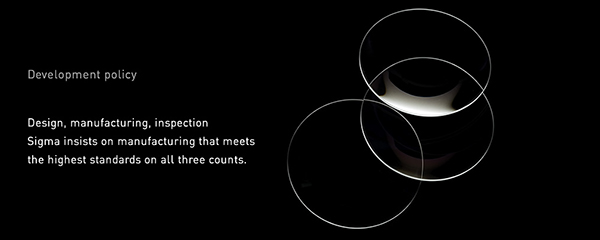On the Sigma Global Vision site, you may read and learn about every aspect of the evolution of Sigma. In this occasional blog series, we discuss aspects of the Global Vision in greater depth.

The Global Vision explains:
There are three requirements for outstanding lenses: fine design, precise manufacturing and inspection that ensures compliance with all specifications. Sigma lenses are born of well-thought-out design concepts and sophisticated, advanced Japanese manufacturing technology: the final clincher is our lens performance evaluation.
We used to measure lens performance using conventional sensors. However, we’ve now developed our own A1 proprietary MTF (modulation transfer function) measuring system using 46-megapixel Foveon direct image sensors. Even previously undetectable high-frequency details are now within the scope of our quality control inspections. The lenses in our new lines will all be checked using this new system before they are shipped.
Thanks to our new sensors, with their extremely high resolution, you can expect our high-performance lenses to be better than ever.
At the heart of the A1 measurement system is the same Merrill Generation 46 Megapixel Foveon sensor in the Sigma SD1 Merrill, and the Merrill Generation DP cameras. The incredible resolution of this sensor makes it perfectly suited to this advanced scientific purpose. The lenses to be measured are hooked up to the image capture device, and the special charts are captured and analyzed using new, proprietary algorithms designed to work in conjunction with the high-resolution sensor. This level of detail analysis is critical for creating lenses capable of meeting the demands of the most detailed image sensors in cameras such as the Sigma SD1 Merrill and the Nikon D800.
As you know, the 46-megapixel Merrill Generation Foveon sensor is APS-C format, capable of both super high resolution and super micro detail. So, in order to test the lenses edge to edge, and corner to corner, to cover the entire 35mm image circle, the first test image is made at the center of the frame, and then the sensor is moved to a corner of the image circle, and repeated for each remaining corner. The data is analyzed and the tester then determines if the lens has met the quality control standards.
And every new lens designed in the Contemporary, Art, and Sports lines will be tested with the A1 device–meaning 100% of the lenses built will be analyzed and approved before leaving the factory in Aizu.
Today’s best-resolving cameras demand lenses with the highest level of optical performance, and using A1 MTF testing on every lens produced ensures the each lens manufactured is up to both the high standards of Sigma and the demands of the most discerning photographers–and their cameras.
The first of the new lenses, the Sigma 35mm F1.4 DG HSM is available now.

If all new lenses can all become as great as the one in my DP2M, then I will shout a very loud “WOW” !
Where can we find the MTF charts for the 35mm f1.4 and other lenses that you’ve omitted on your website?
Great news! Sigma quality is getting even better. For my Canon cameras I just purchased a Sigma 24-70mm lens for $800 since the Canon version is now $2400. I love the quality and 4 year warranty that Sigma gives. The choice has not disappointed me.
Great!!!!!!!
For the color-blind, the Nikon D800E might be OK, hoping that one can ever make an RGGB screen to avoid Bayer matrixing problem, and that the industry standards require to say its a 14-bits per pixel sensor, as opposed to 36-bits per pixel for the Merrill sensor.
What we really need from Sigma is a viewer that allows to view an X3F on a 12-bpc screen or better at full resolution. IGZO & QDEF are on the way, with 8K displays around the corner, so finally the average Merrill user will be able to view what the Merrill sensor can deliver at 100% scaling, deep color and proper dynamic range, rather than claiming banding and other picture degradation incurred by *.jpg
Also if RGB subpixels can be aligned (e.g. Christie CP4230 projector), this would be homothetic with input transducer, rather than spreading an overlapping RGB pixel.
Maybe it’s time for a Foveon screen !
Hopefully SPP will be able to export to jpeg XR or Open EXR or LUV tif unless one can use it to see the X3F, so everyone on the planet can have SPP to view pictures not intended for color-blind.
Keep the good work….
Some years ago I was among the most vocal critics of Sigma, not for lens design, which has always been excellent, but because service and quality control were, in my opinion, not up to snuff.
I want now to be among the first to congratulate Sigma on moving to the forefront, serving as an example that a company can make what were once weaknesses a strength. Sigma factory service has become a pleasant and efficient experience to those who need it.
Now you are setting the standard by actually giving your customers the ability to fine-tune their lenses with the Optimization Pro software and USB Dock, and actually optically testing your lenses before shipping.
I believe in a few years other manufacturers will be imitating the initiatives Sigma has started.
I just wanted to take a moment to express my congratulations and admiration for the efforts Sigma Corporation is making.
Roger Cicala
Roger, thank you for the note. It is truly appreciated.
Since each lens is individually tested, do we receive any report from those tests ?
Are they available as a pdf download, for example, after you register your lens (serial number) ?
Thank you.